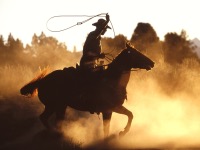Rodeo
Origin
Spanish, from rodear to surround, from rueda wheel, from Latin rota
In Spanish America, the rodeo was the process that was used by vaqueros to gather cattle for various purposes, such as moving them to new pastures, separating the cattle owned by different ranchers, or gathering in preparation for slaughter (matanza). The term was also used to refer to exhibitions of skills used in the working rodeo. It was this latter usage which was adopted into the cowboy tradition of the United States and Canada.
The term rodeo was first used in English in approximately 1834 to refer to a cattle round-up. Today the word is used primarily to refer to a public exhibition of cowboy skills, usually in the form of a competitive event.
Definitions
- 1: an event in which people compete at riding horses and bulls, catching animals with ropes, etc.
- 2: roundup
- 3a : a public performance featuring bronco riding, calf roping, steer wrestling, and Brahma bull riding
- b : a contest resembling a rodeo
Description
Rodeo (/ˈroʊdiːoʊ/ or /roʊˈdeɪ.oʊ/) is a competitive sport that arose out of the working practices of cattle herding in Spain, Mexico, and later the United States, Canada, South America, Australia and New Zealand. It was based on the skills required of the working vaqueros and later, cowboys, in what today is the western United States, western Canada, and northern Mexico. Today it is a sporting event that involves horses and other livestock, designed to test the skill and speed of the cowboys and cowgirls. American style professional rodeos generally comprise the following events: tie-down roping, team roping, steer wrestling, saddle bronc riding, bareback bronc riding, bull riding and barrel racing. The events are divided into two basic categories: the rough stock events and the timed events. Depending on sanctioning organization and region, other events such as breakaway roping, goat tying, or pole bending may also be a part of some rodeos.
American rodeo, particularly popular today within the Canadian province of Alberta and throughout the western United States, is the official state sport of Wyoming, South Dakota, and Texas. The iconic silhouette image of a "Bucking Horse and Rider" is a federal and state-registered trademark of the State of Wyoming. The Legislative Assembly of Alberta has considered making American rodeo the official sport of that province. However, enabling legislation has yet to be passed.
In the United States, professional rodeos are governed and sanctioned by the Professional Rodeo Cowboys Association (PRCA) and Women's Professional Rodeo Association (WPRA), while other associations govern children's, high school, collegiate, and senior rodeos. Associations also exist for Native Americans and other minority groups. The traditional season for competitive rodeo runs from spring through fall, while the modern professional rodeo circuit runs longer, and concludes with the PRCA National Finals Rodeo (NFR) in Las Vegas, Nevada, now held in December.
Rodeo has provoked opposition from animal rights and animal welfare advocates, who argue that various competitions constitute animal cruelty. The American rodeo industry has made progress in improving the welfare of rodeo animals, with specific requirements for veterinary care and other regulations that protect rodeo animals. However, rodeo is opposed by a number of animal welfare organizations in the United States and Canada. Some local and state governments in North America have banned or restricted rodeos, certain rodeo events, or types of equipment. Internationally, rodeo is banned in the United Kingdom and the Netherlands, with other European nations placing restrictions on certain practices.[1]
